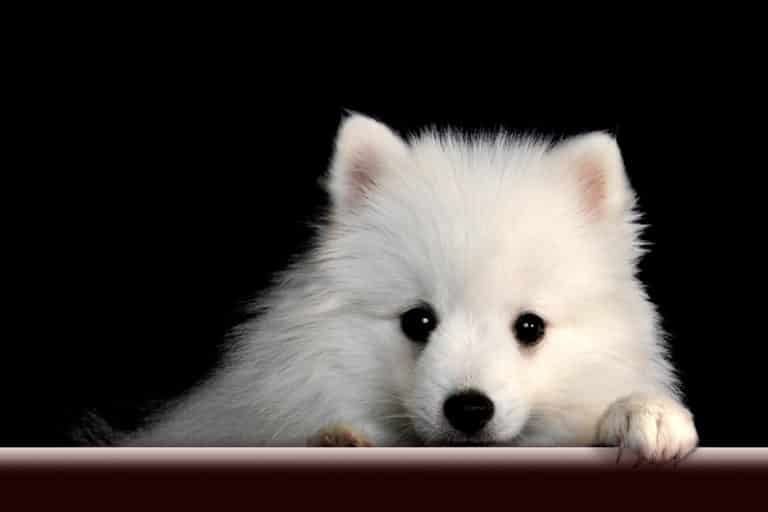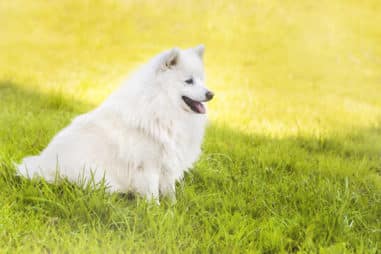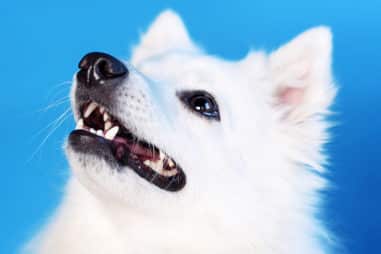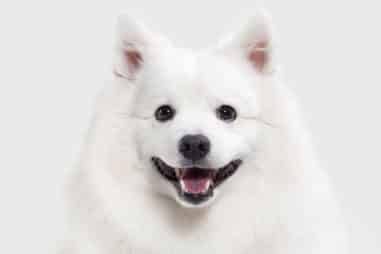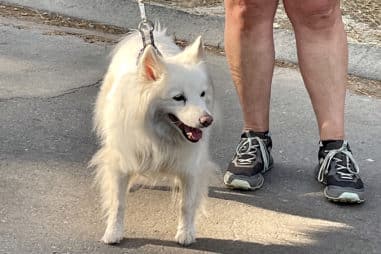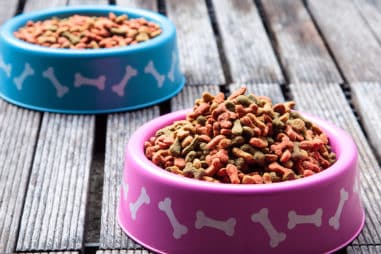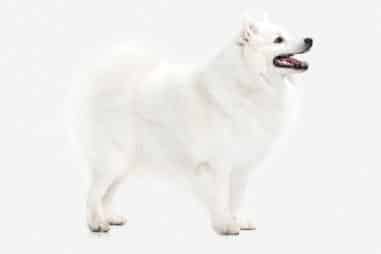The Japanese Spitz is a little comedian who wants to make you smile and laugh. Loyal and intelligent, they make wonderful dog companions. They are always in the mood for adventure and will tag along on a hiking trip, a drive to the beach, or a day at the lake. Simply put, these animals love being with their humans.
How Long Are Japanese Spitz Pregnant For?
It is necessary to understand the nature of the canine reproductive cycle first before you can really give an accurate answer to this question, “for how long are dogs pregnant for?”
A Japanese Spitz’s pregnancy lasts on average 60 to 64 days. The telltale signs of a pregnant or lactating Japanese Spitz include:
- Loss of appetite
- Vomiting is common in the early stages of the pregnancy
- They may appear lethargic and their energy is almost depleted all the time.
Like other breeds, they go into heat or sexual maturity two times a year and will remain in that mature condition for sexual activity for around 3 weeks or so.
This applies also to all dog breeds. Provided that your female Japanese Spitz is in the pink of health, she’d go into heat with the gap of every six months. Age is also another determining factor in canine heat.
Hence, as they get older their heat phase may become infrequent. There are also cases that they have what is known as a “silent heat”, which is characterized by the absence of bloody discharge from their vulva. So despite the absence of bloody discharge, they are still in heat, anyway.
The duration of the canine heat cycle is generally around 18 to 21 days, with four distinct phases occurring during this time. Seasoned dog breeders utilize these stages to select the ideal moment to mate their dogs and thus ensure successful coitus or intercourse between the dam and the sire. While in heat, the dam (female dog in heat) can breed with numerous males (sire).
For three weeks, the dam will be in heat. If your dog is in heat, you’ll see swollen vulva and bloody discharge coming from her.
If you have a male dog at home, regardless of breed, his tendency is to become insanely attracted to your dam while in heat, owing to the chemical surges happening inside your dam’s reproductive parts. On the other hand, dams generally do not show a great deal of interest in the male dogs hounding them until she reaches her 6-11 day stage of heat.
How Many Puppies Does a Japanese Spitz Give Birth To?
The average litter size of Japanese Spitz dogs is about 1 to 6 puppies only. Since they have a small build, it makes sense that their bodies can only accommodate to produce puppies up to that number only.
Having more than 6 puppies in this dog breed’s womb could threaten the life of both the dam herself and her unborn puppies. Fortunately, this scenario seldom happens in Japanese Spitzes.
If your Japanese Spitz dam is well taken care of during her pregnancy, at the peak of health and relatively still young (around 3 to 6 years old), there is a good possibility that all her litter will come out alive and strong. Thus, the puppies will stand a good chance of survival after birth.
However, past the age of 7 years old, there is a certain level of risk in dogs if they will still get pregnant and the risks would further intensify even more while giving birth.
Right before your Japanese Spitz dam gives birth to her young, a whelping box should have been prepared for her. A whelping environment can be any set place that is designed to specifically help and provide the dam’s nesting requirements. You may help your pooch on this aspect by creating a soft cushioned environment for her litter to emerge in.
To prepare a makeshift whelping box, grab several pieces of old blankets that you don’t use anymore or towels and lay them neatly on a large piece of a cardboard box. Your dog, who is about to give birth, will instinctively know on her own how to position her body on it.
How Many Puppies Can a Japanese Spitz Have?
As previously stated, the average litter size of a Japanese Spitz dog, being a small breed, is 1 to 6 puppies only. This may not be a big number, but it could be one of the reasons why Japanese Spitz dogs are so rare. And maybe also among the underlying factors why breeders for this type of dog are hard to come by.
In addition, there is no guarantee that all of the dam’s puppies would come out alive and strong. Some of them would live and survive long, depending upon the dam’s overall health; others, particularly the weakest and really small ones, have a slim chance of making it after birth.
According to the observation of many seasoned Japanese Spitz breeders, an average of 4 out of 6 puppies is likely to survive after birth. This only goes to show that the mortality rate in this canine breed is high among puppies, particularly right after birth.
Dystocia is one of the complications that small breed dogs are likely to suffer from when giving birth to their puppies.It could also explain the high rate of mortality among Japanese Spitz puppies. And since this canine breed is a qualified small to medium size dog, they are also susceptible to this condition while still in labor or giving birth.
Dystocia is characterized by various levels of difficulties that a dam could suffer from when giving birth to her babies. Therefore, keeping watchful, vigilant eyes on your Japanese Spitz dam during her labor is paramount to her safety and the survival of all her litters.
Telltale signs of dystocia in a dam giving birth to her litter include:
- High fever.
- Painstaking or prolonged labour time.
- Vomiting.
- Extreme weakness but no puppy is delivered yet.
- Strong contractions lasting for more than an hour but there is no actual delivery.
Depending on the severity of the circumstance, a Cesarean Section (C-section) may be advised and performed in most cases. Thus, it is in your dog’s best interest to have ready access to a reputable veterinary clinic prior to your dam’s estimated date of labor.
How Do You Take Care of a Japanese Spitz Puppy?
Here are some basic tips on how to care for a Japanese spitz puppy.
First, you’ll need to buy some supplies. Of course, you’ll need to get food and water bowls, but it’s also important that your puppy has a leash, collar, bed or blanket that smells like home (if possible), toys, shampoo (unless they get baths at a groomer’s), and an ID tag.
You should also buy a brush, toothbrush, and nail clippers while you’re out shopping for supplies. Now that we have the basics covered, let’s talk about how to take care of a Japanese spitz puppy inside your house.
First things first, you’ll have to get your new furbaby housebroken. What does this entail? This will involve letting the puppy explore the surroundings of his new home including your outdoor spaces. Give your dog some water and allow it to play with it if it wants to until it tires him out, and put it back in its crate for a nap.
As for what to feed your new puppy, whether to do so in a crate or not, and whether to mix wet food with dry food should all depend on how your puppy responds.
A normal puppy feeding plan would look something like this:
- Between the ages of 6 and 16 weeks, three to four meals per day are recommended (4 meals only for very small breeds).
- 3-6 months of age: 1-2 meals daily.
- Between the ages of 6 and 12 months, two meals per day are recommended.
Make sure to provide lots of chew toys, too! If you leave your puppy outside the house for long periods by itself, make sure to bring it inside at a later time. The puppy will need a lot of attention from you, so make sure to carve out some time every day.
In addition, avoid feeding your Japanese Spitz puppy food scraps off your plate. Doing so will make your young pup think that it is okay to constantly beg for a share of every single food item you eat. While it is not generally harmful, it is a very difficult habit to break.
Therefore make sure to come up with a puppy diet and a feeding schedule. And make sure that you stick to it because it will make your life easier while caring for a young puppy.
Begin early, train your puppy to eat with you. Until such time that he learns the concept of what good behaviour is all about, you may have him inside his crate or bar him from the dining room or kitchen area.
When is the Best Time for Your Japanese Spitz Puppy’s First Visit to the Vet?
The best time to get a Japanese Spitz puppy on their first vet visit is when they reach 6-8 weeks old after birth. Perhaps you can wait until they are closer to 10 weeks old, but we don’t recommend it.
There is no reason to encourage you to delay your puppy’s first vet visit. When the right time comes for your puppy to go to a veterinarian, you should seize the opportunity and not dilly-dally about it. The longer you wait to bring your puppy to a vet clinic, the more prone your puppy becomes to various health conditions that may be induced by viral and bacterial infection.
Any kind of bacterial and viral infection can be fatal to a young puppy, especially if they are in the weaning phase already. They are most susceptible because when they are past the age of 8 weeks old, the dam, or the mother dog, is likely to keep them from suckling on her for milk.
This will cause the puppies’ immune system to degrade and thus lose its shield of protection, immunity against microbes and viruses. Hence, the litter will become even more prone to infection with a delicate health condition.
Aside from giving anti-rabies shots, which are usually administered 180 days or around 3 months after birth, vaccination booster shots for a Japanese Spitz puppy can help in keeping him from contracting dangerous illnesses that can cost him his life.
What Is the Best Food for a Japanese Spitz Puppy?
Kibbles are the best food to offer your Japanese Spitz puppy. These are the commercially-produced pet food pellets that you see in pet stores. They usually come in dry, small form, and may come in wet and dry varieties. This is also the kind of dog food highly recommended by seasoned breeders and veterinarians alike.
Others would ask why this type of dog food is so popular and common? Is it truly the finest diet we can give to our puppies in general, and young Japanese Spitzes?
Here are some good and practical reasons why kibbles are topping the food options for puppies.
Fast and simple meals. Since you may not always have time or desire to prepare a full meal every day for your young Japanese Spitz puppy, such as meat, vegetables, cereals, etc.
There’s nothing easier than putting the kibbles in a bowl and dripping the portion of food in and your dog’s meal is ready! This is the most convenient way to feed your young pooch.
Guaranteed nutritional balance. Japanese Spitz owners should make sure they feed their dog kibbles to avoid making nutritional and quantitative mistakes.
Food options of this type also guarantee that you are giving your young puppies food items that are of good sanitary quality. This means to say that what your Japanese Spitz puppy will eat is free from harmful bacteria and no risk for pesky parasites.
Is Milk Good for a Japanese Spitz Puppy?
You can give milk to your Japanese Spitz puppy but you need to take caution on this. There is an array of things to consider here before you offer milk to your pooch. Milk is not usually toxic or harmful to our fur babies when they consume or drink milk in tad amounts only.
But there are exceptions to this. Dogs who consume large quantities of milk or dairy products run the risk of suffering from a number of health consequences. If you plan on sharing milk with your dog, make sure you are on the safe side of things by consulting your veterinarian first.
Cow’s milk or goat’s milk are both suitable for dog’s consumption, however, make sure that your pooch is not lactose intolerant or is not allergic to it. More than anything else, it is the consequence of milk consumption that we must worry about.
It is not unusual for puppies to have an abundance of enzymes in their digestive system because they need them to effectively and fully digest their mother’s milk. Milk contains a type of sugar called “lactose”, and to break it down in its digestible form, a puppy’s body needs to produce an enzyme called “lactase”.
Unfortunately, not all dogs can produce lactase in their system. Thus, offering them milk may not be a good choice to make.
Even though milk isn’t necessarily toxic to dogs, it can help bring about a gamut of problems down the road. Unfortunately, many dogs are lactose intolerant, which means they have difficulty digesting dairy products. And thus, milk is something they need to shy away from.
Typical signs to watch out for if your puppy/dog is lactose-intolerant are the following symptoms:
- Bloating
- Abdominal pain
- Vomiting
- Loose consistency of their stool
- Diarrhea
- Constant gas/flatulence
In the case of lactase deficiency, milk consumption leads to diarrhea and vomiting. Furthermore, whole milk and other dairy products sometimes contain too much fat which can also have similar effects, induce to diarrhea and vomiting.
Consuming dairy products, especially whole milk, runs the risk of pancreatic damage in dogs, which vets all over the world agree with as a highly serious medical condition. Most of the time, it can prove to be fatal, too.
It is fine to occasionally let your dog lap some milk or lick some ice cream, but seriously don’t make that a habit. In general, dogs can suffer from an upset stomach within 12-48 hours of drinking milk or eating milk-derived products. Therefore, the ill effects of milk consumption are not immediate but there are occasions that it might take some time to manifest.
How Much Should I Feed My Japanese Spitz Puppy?
Since puppies are a work in progress, it is natural that their bodies will require more food than adult canines. When dogs get older, they tend to eat less food.
Puppies of Japanese Spitz breeds can consume up to 40 ounces of food at a time and as they become older, this reduces to 20-30 ounces per day only.
You should feed your puppy (regardless of breed) according to how much he will weigh as an adult. Therefore, it is important that you know what their ideal weight would be as an adult Japanese Spitz dog. By this measure, you can come up with a close to accurate estimation of the right amount of food you should serve to your puppy.
For example, a Labrador Retriever will be heavier at maturity than a Russell Terrier. This implies that the larger puppy will require more food in the early stages of his development.
To give you an idea of how to make calculations on the right amount of food to serve your fur baby, consider the following steps. A
- Know your puppy’s estimated adult weight. (11-20 pounds for Japanese Spitzes. This is equivalent to 4.98 to 9.071 kg).
- Know what their daily calorie intake should be. (To keep a healthy weight, most dogs require 25 to 30 calories per pound every day.)
- Calculate the quantity required to meet daily calorie requirements by consulting the food label for “calories per serving.
- Determine how many meals your dog requires per meal frequency, a chart for puppies will tell you this.
- Subtract the weight of food determined in step 3 from the number of meals determined in step 4.
How Many Times Should a Japanese Spitz Puppy Eat?
After determining the daily food volume you can offer your puppy, the next thing in line for you is to develop or come up with a feeding program for your furbaby. Divide the daily food needed for your dog into two to three smaller meals. Then, those partitioned quantities of food to your dog at regular times throughout the day.
Of course, the simplest puppy feeding plan you can have is to feed him whenever you eat—at breakfast, lunch, and dinner.
It is also recommended that you feed your puppy early in the evenings to give his digestive system an ample amount of time to digest his food before bedtime. Additionally, this works to your puppy’s advantage because it will help his body prevent mishaps on the inside.
The key here is consistency. Consistently feeding puppies at the same times each day will help them develop a sense of routine, a concept that is a precursor to discipline.
When to Discontinue Puppy Food Feeding to Your Japanese Spitz Puppy?
In order to know the best time to switch your puppy from consuming puppy food to start liking and consuming adult dog food, you need to know first when they will reach maturity. If you have that information with you, then you can decide on the best time to start the transition.
In the case of Japanese Spitzes, know that they reach maturity rather more quickly than other canine breeds. At 8 months old, they would have reached their maximum height and are thus considered mature or fully grown adult dogs.
It might take 7 to 10 days to make the shift, and sometimes it is going to be a gruelling process. Therefore, you might want to prepare ahead of time before doing the actual switch. Choosing the right kind of kibble products for this matter would also help.
Consider getting a kibble brand that comes with a pleasant aroma and has a moist texture rather than something that is hard and doesn’t have a pleasing smell at all.
A moist dog food product is preferred by most dogs, regardless of breed. It is because moist kibble products are far easier for them to chew. Thus, if he is not going to have a hard time chewing on his new food, the odds that he will like his new food is higher than you have ever thought.
How Big Can Japanese Spitzes Get?
At the shoulder, the average adult Japanese Spitz stands 12 to 16 inches or about 30 to 40 cm, with males about an inch taller than females. In terms of weight, an adult Japanese Spitz will usually weigh between 15 and 30 pounds or equivalent to 7 to 13.5 kg. This will be highly dependent though on its height and body type.
For the most part, this places the Japanese Spitz in the “small to medium size dog” category, which includes all breeds weighing between 0 and 25 kilograms or about 11 kg.
At What Age Is a Japanese Spitz Full Grown?
From birth to adulthood, the development of a Japanese Spitz puppy is approximately 12-14 months. Their transition to adulthood is faster than other breeds because they are a small-size breed.
With respect to their physical attributes, the Spitzes grow rapidly in height and length for the first six months of their lives, after which their measurements begin to plateau as the adolescent puppy gains muscle mass; Spitzes are usually at or near full size by the time they reach the age of 10-12 months.
On the social front, things are progressing steadily, too. In general, puppies achieve puberty quite early lasting for about 3-4 months.
When they reach 7-8 months, they have reached sexual maturity. Thus, female Japanese Spitzes would start their heat stage and their vulva will start secreting bloody discharge By 12-14 months, they are considered a fully developed or mature Japanese Spitz dog.
When Do Japanese Spitz Ears Stand Up?
Unlike other dogs in the Spitzes canine family, Japanese Spitzes are born with their ears folded over. As they grow older though, they tend to open better and thus would become even more upright, or erect, in their appearance.
As a general rule, you should expect the ears of your Japanese Spitz to become upright anywhere from 6 weeks to several months after being born.
Similarly, in the case of other canine breeds, their ears normally come into position in around 8 to 10 weeks, however, some may take as long as 6 or 7 weeks in some cases. Some dogs may also go through a stage in which one ear is higher up on the head than the other.
How Can I Tell If My Puppy Is a Japanese Spitz?
Looks can be deceiving at times, even in dogs. There is no better way to identify a purebred Japanese Spitz puppy than by looking into its parentage. The Japanese Spitzes are among the nearly impossible dog breeds to find not just in the US but in other parts of the globe, too. So, when you get one you need to know if it is authentic or a purebred or not.
The Japanese Spitz is derived from the native Spitz of Japan, called “Nihon Supittsu” in Japanese. They were originally used for tracking, hunting, and herding cattle and animals.
The coat of a Japanese Spitz puppy should be white with either blonde or red tips. In the same way that a Pomeranian’s tail curls over its back, the tail of a Japanese Spitz should do the same. Ideally, their head should resemble that of a fox, with a pair of upright triangular ears that are also tipped in red or blonde fur.
In general, these puppies should have a V-shaped black eyebrow. The ears of an adult Japanese Spitz should stand at attention, but the fur should be soft and not coarse.
If the puppy is younger than five months, signs of incorrect color or shape may still come out. Therefore, don’t qualify those as something amiss in your puppy. There is no reason to panic if, in the first five months of life, their ears would not stand fully upright, or the muzzle may appear slightly longer. The coloring on these puppies will usually not be complete until they are four or five years old.

